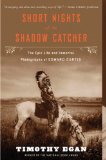Summary | Excerpt | Reading Guide | Reviews | Beyond the Book | Read-Alikes | Genres & Themes | Author Bio
The Epic Life and Immortal Photographs of Edward Curtis
by Timothy Egan

Critics' Opinion:
Readers' Opinion:
First Published:
Oct 2012, 384 pages
Paperback:
Aug 2013, 384 pages
 Book Reviewed by:
Book Reviewed by:
Jo Perry
Buy This Book
This article relates to Short Nights of the Shadow Catcher
Edward Curtis, with the help of his assistants in his Seattle studio, produced photogravure prints - over 40,000 of the North American Indian alone. The elaborate process produced sepia pictures with soft glowing tones.
The photogravure process, which really took off in the late nineteenth century, is widely considered as elevating photography to an art form. The process involves three basic steps: capturing the subject on film; creating an etched copper plate of the captured image and running off prints from this etched copper plate. The copper plate that is used as the base for prints is etched at different depths depending on the amount of darkness in the picture. The result is that darker portions of a picture create deeper etches in the plate. When the plate is inked and prints run off, deeper portions hold more ink and so the print that results is one that is an accurate reproduction of the original. For each sepia print that Curtis made using this process, the corresponding copper plate had to be cleaned and re-inked. Some of his prints were also hand-colored.
 Curtis also created images using a process called goldtone, which he adopted and refined to such an extent that he called them "Curt-Tone" images. Unlike other prints which are on paper, Curt-Tone images projected the negative of a film onto a glass sheet which was then treated with chemicals to capture and save the image permanently. Curtis described these images, which had warmth, depth and a translucent quality, as "full of life and [sparkling] like an opal." He traveled Native American lands for thirty years hauling the heavy glass plates that were needed for this process.
Curtis also created images using a process called goldtone, which he adopted and refined to such an extent that he called them "Curt-Tone" images. Unlike other prints which are on paper, Curt-Tone images projected the negative of a film onto a glass sheet which was then treated with chemicals to capture and save the image permanently. Curtis described these images, which had warmth, depth and a translucent quality, as "full of life and [sparkling] like an opal." He traveled Native American lands for thirty years hauling the heavy glass plates that were needed for this process.
Curtis manipulated his images and adjusted them according to his vision. He removed tokens of contemporary life - such as an alarm clock in a Hopi residence - in order to present the life of indigenous Americans as it had been lived, not as it was when he documented it. Some have suggested that Curtis presented an idealized version of the native American but one could argue that he was providing a snapshot from an earlier time, recording Native cultures, not present-day "reality." He was conserving what was fast dying out. He made sure to photograph, as he did with Princess Angeline, his subjects in their traditional clothing performing activities that were traditional as well. Only one of the 40,000 photos shows a Native American man in "western" clothing.
The long-lost volumes of Curtis's The North American Indian are now accessible online courtesy of the Northwestern University Library. You can search by tribe or by volume: loc.gov. For more information on Curtis's techniques, go to edwardcurtisphotographer.com.
Some of Edward Curtis's orotones or Curt-tone images were featured on PBS's Antiques Roadshow. Click on the video below for a look:
Watch Appraisal: Edward Curtis Orotones, ca. 1908 on PBS. See more from Antiques Roadshow.
The haunting image of 'Princess' Angeline captured a poor Native American after whose father, the city of Seattle was named. Angeline was one of Edward Curtis's earliest Native American photography subjects.
Filed under Music and the Arts
![]() This "beyond the book article" relates to Short Nights of the Shadow Catcher. It originally ran in October 2012 and has been updated for the
August 2013 paperback edition.
Go to magazine.
This "beyond the book article" relates to Short Nights of the Shadow Catcher. It originally ran in October 2012 and has been updated for the
August 2013 paperback edition.
Go to magazine.





The Flower Sisters
by Michelle Collins Anderson
From the new Fannie Flagg of the Ozarks, a richly-woven story of family, forgiveness, and reinvention.

The House on Biscayne Bay
by Chanel Cleeton
As death stalks a gothic mansion in Miami, the lives of two women intertwine as the past and present collide.

The Funeral Cryer by Wenyan Lu
Debut novelist Wenyan Lu brings us this witty yet profound story about one woman's midlife reawakening in contemporary rural China.
Your guide toexceptional books
BookBrowse seeks out and recommends the best in contemporary fiction and nonfiction—books that not only engage and entertain but also deepen our understanding of ourselves and the world around us.